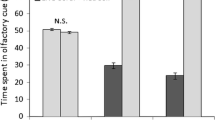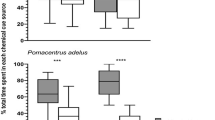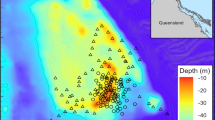Abstract
The present study (Ishigaki Island, Japan) explored the distance of transmission of chemical cues emitted by live versus dead coral reefs (Exp. 1: High performance liquid chromatography (HPLC) analyses with water sampling station at 0, 1, and 2 km away from the reef) and the potential attraction of these chemical cues by larval fish, crustaceans, and cephalopods (Exp. 2: choice flume experiment conducted on 54 Chromis viridis larvae, 52 Palaemonidae sp larvae, and 16 Sepia latimanus larvae). In the experiment 1, HPLC analyses highlighted that the live coral reef (and not the dead coral reef) produced different and distinct molecules, and some of these molecules could be transported to a distance of at least 2 km from the reef with a reduction of concentration by 14–17-fold. In the experiment 2, C. viridis, Palaemonidae sp, and S. latimanus larvae were significantly attracted by chemical cues from a live coral reef (sampling station: 0 km), but not from a dead coral reef. However, only C. viridis larvae detected the chemical cues until 1 km away from the live coral reef. Overall, our study showed that chemical cues emitted by a live coral reef were transported farthest away in the ocean (at least 2 km) compared to those from a dead coral reef and that fish larvae could detect these cues until 1 km. These results support the assumption of a larval settlement ineffective in degraded coral reefs, which will assist conservationists and reef managers concerned with maintaining biodiversity on reefs that are becoming increasingly degraded.





Similar content being viewed by others
References
Arvedlund M, Kavanagh K (2009) The senses and environmental cues used by marine larvae of fish and decapods crustaceans to find tropical coastal ecosystems. In: Nagelkerken I (ed) Ecological connectivity among tropical coastal ecosystems. Springer, New York, pp 135–185
Atema J (1996) Eddy chemotaxis and odor landscapes: exploration of nature with animal sensors. Biol Bull 191:129–138
Atema J, Kingsford MJ, Gerlach G (2002) Larval reef fish could use odour for detection, retention and orientation to reefs. Mar Ecol Prog Ser 241:151–160
Baker CF, Montgomery JC (2001) Species-specific attraction of migratory banded kokopu juveniles to adult pheromones. J Fish Biol 58:1221–1229
Blumstein DT, Bouskila A (1996) Assessment and decision making in animals: a mechanistic model underlying behavioural flexibility can prevent ambiguity. Oikos 77:569–577
Browne KA, Zimmer R (2001) Controlled field release of a waterborne chemical signal stimulates planktonic larvae to settle. Biol Bull 200:87–91
Bruno JF, Selig ER (2007) Regional decline of coral cover in the Indo-Pacific: timing, extent, and subregional comparisons. PLoS ONE 2(8):e711
Dill LM (1987) Animal decision making and its ecological consequences: the future of aquatic ecology and behavior. Can J Zool 65:803–811
Dixson DL, Jones GP, Munday PL, Planes S, Pratchett MS, Srinivasan M, Syms C, Thorrold SR (2008) Coral reef fish smell leaves to find island homes. Proc Biol Sci 275:2831–2839
Dixson DL, Pratchett MS, Munday PL (2012) Reef fishes innately distinguish predators based on olfactory cues associated with recent prey items rather than individual species. Anim Behav 84:45–51
Doherty PJ (2002) Variable replenishment and the dynamics of reef fish populations. In: Sale PF (ed) Coral reef fishes: dynamics and diversity in a complex ecosystem. Academic Press, San Diego, pp 327–358
Feary DA, Almany GR, McCormick MI, Jones GP (2007) Habitat choice, recruitment and the response of coral reef fishes to coral degradation. Oecologia 153:727–737
Fuzessery ZM, Childress JJ (1975) Comparative chemosensitivity to amino acids and their role in the feeding activity of bathypelagic and littoral crustaceans. Biol Bull 149:522–538
Fuzessery ZM, Carr WES, Ache BW (1978) Antennular chemosensitivity in the spiny lobster, Panulirus argus: studies of taurine sensitive receptors. Biol Bull 154:226–240
Gerlach G, Atema J, Kingsford MJ, Black KP, Miller-Sims V (2007) Smelling home can prevent dispersal of reef fish larvae. Proc Natl Acad Sci 104:858–863
Gleason DF, Danilowicz BS, Nolan CJ (2009) Reef waters stimulate substratum exploration in planulae from brooding Caribbean corals. Coral Reefs 28:549–554
Hanski I, Gilpin ME (1997) Metapopulation biology: ecology, genetics and evolution. Academic Press, London
Hara TJ (1994) The diversity of chemical stimulation in fish olfaction and gestation. Rev Fish Biol Fish 4:1–35
Holles S, Simpson SD, Radford AN, Berten L, Lecchini D (2013) Boat noise disrupts orientation behavior in a coral reef fish. Mar Ecol Prog Ser 485:295–300
Hughes TP, Baird AH, Bellwood DR, Card M, Connolly SR (2003) Climate change, human impacts, and the resilience of coral reefs. Science 301:929–933
Huijbers CM, Nagelkerken I, Lossbroek PC, Schulten IE, Seigenthaler A, Holderied MW, Simpson SD (2012) A test of the senses: fish select novel habitats by responding to multiple cues. Ecology 93:46–55
Igulu M, Nagelkerken MI, Fraaije R, van Hintum R, Ligtenberg H, Mgaya YD (2011) The potential role of visual cues for microhabitat selection during the early life phase of a coral reef fish (Lutjanus fulviflamma). J Exp Mar Biol Ecol 401:118–125
Jeffs A, Montgomery JC, Tindle C (2005) How do spiny lobster postlarvae find the coast? N Z J Mar Freshw Res 39:605–617
Jones GP, McCormick MI, Srinivasan M, Eagle JV (2004) Coral decline threatens fish biodiversity in marine reserves. Proc Natl Acad Sci 101:8251–8253
Kingsford MJ, Leis JM, Shanks A, Lindeman K, Morgan S, Pineda J (2002) Sensory environments, larval abilities and local self-recruitment. Bull Mar Sci 70:309–340
Lecchini D, Nakamura Y (2013) Use of chemical cues by coral reef animal larvae for habitat selection. Aquat Biol 19:231–238
Lecchini D, Tsuchiya M (2008) Spatial structure of coral reef fish communities at Kudaka Island (Ryukyu Archipelago—Japan). Ichthyol Res 55:321–327
Lecchini D, Pratchett M, Adjeroud M, Cadoret L, Galzin R (2003) Spatial distribution of coral reef fish communities of Ryukyu Islands (Japan). Oceanol Acta 26:537–547
Lecchini D, Shima J, Banaigs B, Galzin R (2005) Larval sensory abilities and mechanisms of habitat selection of a coral reef fish during settlement. Oecologia 143:326–334
Lecchini D, Mills SC, Brié C, Maurin R, Banaigs B (2010) Ecological determinants and sensory mechanisms in habitat selection of crustacean larvae. Behav Ecol 21:599–607
Lecchini D, Carassou L, Frédérich B, Nakamura Y, Mills S, Galzin R (2012) Effects of alternate reef states on coral reef fish habitat associations. Environ Biol Fishes 94:421–429
Lecchini D, Waqalevu VP, Parmentier E, Radford CA, Banaigs B (2013) Fish larvae prefer coral above algal water cues: implications of coral reef degradation. Mar Ecol Prog Ser 475:303–307
Leis JM, McCormick MI (2002) The biology, behaviour, and ecology of the pelagic, larval stage of coral reef fishes. In: Sale PF (ed) Coral reef fishes: dynamics and diversity in a complex ecosystem. Academic Press, San Diego, pp 171–199
Leis JM, Siebeck U, Dixson DL (2011) How nemo finds home: the neuroecology of dispersal and of population connectivity in larvae of marine fishes. Integr Comp Biol 51:826–843
Mann DA, Casper BM, Boyle KS, Tricas TC (2007) On the attraction of larval fishes to reef sound. Mar Ecol Prog Ser 338:307–310
Montgomery JC, Jeffs A, Simpson SD, Meekan M, Tindle C (2006) Sound as an orientation cue for the pelagic larvae of reef fishes and decapod crustaceans. Adv Mar Biol 51:143–196
Moore P, Crimaldi J (2004) Odor landscapes and animal behavior: tracking odor plumes in different physical worlds. J Mar Syst 49:55–64
Munday PL, Dixson DL, Donelson JM, Jones GP, Pratchett MS, Devitsin GV, Døving KB (2009) Ocean acidification impairs olfactory discrimination and homing ability of a marine fish. Proc Natl Acad Sci 21:1–8
Myrberg AA, Fuiman LA (2002) The sensory world of coral reef fishes. In: Sale PF (ed) Coral reef fishes: dynamics and diversity in a complex ecosystem. Academic Press, San Diego, pp 123–148
Nakamura Y, Shibuno T, Lecchini D, Watanabe Y (2009a) Habitat selection by emperor fish larvae. Aquat Biol 6:61–65
Nakamura Y, Shibuno T, Lecchini D, Kawamura T, Watanabe Y (2009b) Spatial variability in habitat associations of pre- and post-settlement stages of coral reef fishes at Ishigaki Island, Japan. Mar Biol 156:2413–2419
Painter SD, Clough B, Garden RW, Sweedler JV, Nagle GT (1998) Characterization of Aplysia attractin, the first water-borne peptide pheromone in invertebrates. Biol Bull 194:120–131
Radford CA, Tindle CT, Montgomery JC, Jeffs AG (2011) Modeling a reef as an extended sound source increases the predicted range at which reef noise may be heard by fish larvae. Mar Ecol Prog Ser 438:167–174
Sano M (2000) Stability of reef fish assemblages: responses to coral recovery after catastrophic predation by Acanthaster planci. Mar Ecol Prog Ser 198:121–130
Shibuno T, Hashimoto K, Abe O, Takada Y (1999) Short-term changes in the structure of a fish community following coral bleaching at Ishigaki Island, Japan. Galaxia JCRS 1:51–58
Simpson SD, Meekan MG, Larsen NJ, McCauley RD, Jeffs A (2010) Behavioral plasticity in larval reef fish: orientation is influenced by recent acoustic experiences. Behav Ecol 117:1098–1105
Sola C, Spampanato A, Tosi L (1993) Behavioural responses of glass eels (Anguilla anguilla) towards amino acids. J Fish Biol 42:683–691
Stanley JA, Radford CA, Jeffs AG (2012) Location, location, location: finding a suitable home among the noise. Proc Biol Sci 279:3622–3631
Suzuki G, Kai S, Yamashita H (2012) Mass standing of crown-of-thorns starfish. Coral Reefs 31:821
Tolimieri N, Haine O, Jeffs A, McCauley RD, Montgomery JC (2004) Directional orientation of pomacentrid larvae to ambient reef sound. Coral Reefs 23:184–191
Wilkinson C (2004) Status of coral reefs of the world. Australian Institute of Marine Science, Townsville, Australia
Wilson SK, Graham NJ, Pratchett MS, Jones GP, Polunin NVC (2006) Multiple disturbances and the global degradation of coral reefs: are reef fishes at risk or resilient? Glob Change Biol 12:2220–2234
Wright KJ, Higgs DM, Belanger AJ, Leis JM (2005) Auditory and olfactory abilities of larvae and juveniles of a coral reef damselfish. Mar Biol 147:1425–1434
Wright KJ, Higgs DM, Belanger AJ, Leis JM (2008) Auditory and olfactory abilities of larvae of coral trout at settlement. J Fish Biol 72:2543–2556
Wright KJ, Higgs DM, Leis JM (2010) Auditory sensitivity in settlement stage larvae of coral reef fishes. Coral Reefs 29:235–243
Zimmer RK, Zimmer CA (2008) Dynamic scaling in chemical ecology. J Chem Ecol 34:822–836
Zimmer-Faust RK, Case JF (1983) A proposal dual role of odor in foraging by the California spiny lobster, Panulirus interruptus (Randall). Biol Bull 164:341–353
Acknowledgments
We are grateful to Y. Akita, K. Inoue, K. Kishimoto, M. Sasaki, and the Okinawa Prefectural Fisheries Research and Extension Center for assistance with the fieldwork and laboratory experiments. This study was supported by grants from the Ministry of Education, Culture, Sports, Science, and Technology of Japan (No. 21780178) and the Japan Science and Technology Agency/Japan International Cooperation Agency, Science and Technology Research Partnership (SATREPS).
Author information
Authors and Affiliations
Corresponding author
Additional information
Communicated by M. A. Peck.
Rights and permissions
About this article
Cite this article
Lecchini, D., Miura, T., Lecellier, G. et al. Transmission distance of chemical cues from coral habitats: implications for marine larval settlement in context of reef degradation. Mar Biol 161, 1677–1686 (2014). https://doi.org/10.1007/s00227-014-2451-5
Received:
Accepted:
Published:
Issue Date:
DOI: https://doi.org/10.1007/s00227-014-2451-5




